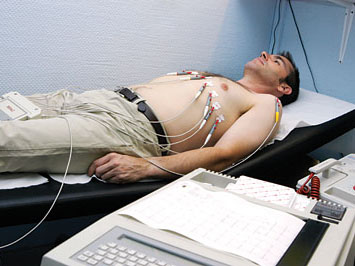Electrocardiography
 An electrocardiogram or EKG is a simple and painless test that measures the electrical activity of the heart and translates it into waves on paper for a doctor to analyze. It is useful as a screening test for the detection and diagnosis of a broad range of cardiac conditions. By examining the wave pattern, your doctor can see the timing and type of the electrical impulses and use it to see the rhythm and heart rate. Underlying problems with the heart can also be noticed with an electrocardiogram.
An electrocardiogram or EKG is a simple and painless test that measures the electrical activity of the heart and translates it into waves on paper for a doctor to analyze. It is useful as a screening test for the detection and diagnosis of a broad range of cardiac conditions. By examining the wave pattern, your doctor can see the timing and type of the electrical impulses and use it to see the rhythm and heart rate. Underlying problems with the heart can also be noticed with an electrocardiogram.
The results from your first EKG will be used by your doctor to compare future electrocardiogram readings to see if any changes took place which might indicate a problem.
How Is the Procedure Performed?
A nurse or technician will clean off the areas of your chest, arms, and legs where the sensory pads will be placed. These will be coated in a gel, which might feel cold to the skin. You will have electrodes attached to your skin, but no electricity will be passed to you. The electrodes only monitor the electrical impulses of your heart.
If you are having a resting EKG done, you will be told to lie completely still during the procedure which can last one to two full minutes. Sometimes your doctor might also ask for a stress test which is an electrocardiogram done while you are on a piece of exercise equipment such as a treadmill or stationary bike. A stress test will last longer, depending upon how quickly your heart rate increases with the exercise.
Is It Safe?
Yes it is safe and painless procedure. No electricity is sent through the electrodes used by the EKG.
